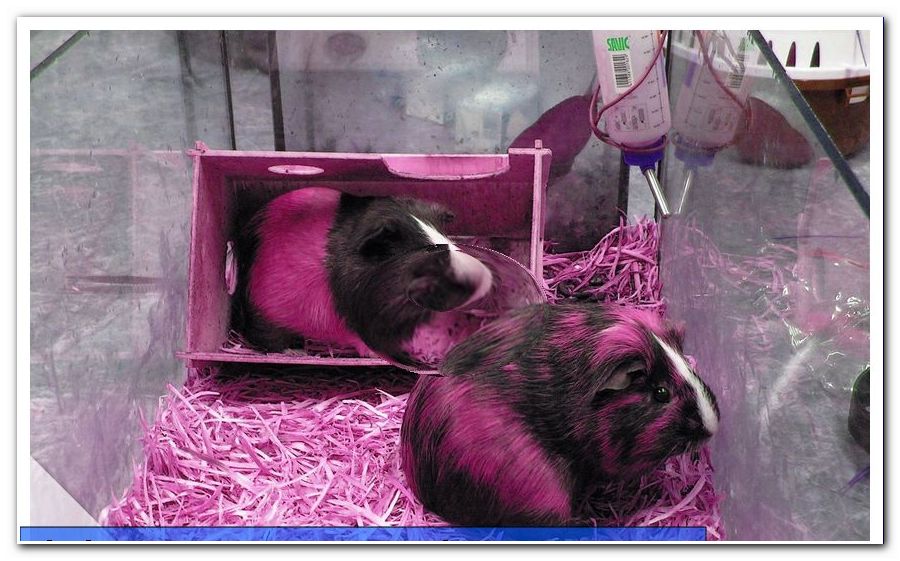Sewing bag for hanging - DIY toiletry bag + pattern

- material selection
- Amount of material and the pattern
- Sewing toiletry bags - this is how it works
- The breakdown
- The suspension
- Feeding and sewing
- The fine touch
The toilet bag, or Toiletry bag called, may not be missing on vacation. Practical bags in the right size and with enough compartments are rare to buy. If you make yourself a DIY toiletry bag, you can customize the bag in shape and color individually. In this tutorial we will show you how to sew a toilet bag for hanging - our pattern is also suitable for beginners.
Step by step to the self-sewn toilet bag
Although the holiday season is already here, but the wellness time begins and often lacks the right storage option for all cosmetics. Above all, the bathrooms in the hotels are often very small and there are hardly any parking spaces. For these reasons, I would like to show you today how you can easily sew a toilet bag for hanging. You can adjust the dimensions and the design according to your requirements. Alternatively, you can of course also sew a toiletry bag. However, in my opinion, there is a big difference between toilet bag and toilet bag: In the toilet bag is always a certain order given by the division into different compartments and pockets with zipper. In the toiletry bag, however, everything is always confused. But that's a matter of taste. In today's tutorial, I present a toilet bag for hanging with a corresponding pattern.
Difficulty level 2/5
(suitable for beginners)
Material costs 2/5
(depending on the choice of fabric between EUR 0, - from the remaining utilization and EUR 40, -)
Time expenditure 2/5
(including pattern depending on the type of selected bags about 2 hours)
material selection
For the toilet bag for hanging you should ideally use non-stretchable fabrics, which you also reinforce with non-woven fabric. The zip pocket should be lined with a water repellent fabric. If you want, you can also reinforce the entire bag with volume fleece (approx. 3 mm). In addition, you need a drawstring (about 50 cm long) and matching woven band (also about 50 cm long).

Amount of material and the pattern
The amount of material depends of course on the respective pattern. My toilet bag should be 25 cm wide and 15 cm high when closed. When opened, the height measures 45 cm and the width remains at 25 cm.
Thus, according to the pattern, I need the following blanks plus seam allowances (about 0.7 cm):
- Background and back each 25 cm x 45 cm
- Fabric for the upper compartments and the zip pocket each 25 cm x 20 cm (should be 10 cm high)
- Zipper min. 25 cm long or endless zipper
- Woven ribbon and cord each about 50 cm long
- (Volume fleece 25 cm x 45 cm)
Tip: The pattern of my laundry bag for hanging consists of a pocket with zipper and a compartment with three divisions. You can add more pockets as you like and also change the outer dimensions. Keep in mind that the pocket width must always be the same as the outer dimension of the background and that you add the appropriate seam allowances.
First apply the iron-on fleece to all fabrics and then cut with seam allowances. If you want or if the fabric frayed very much, you can also complete all cut-out fabric pieces.
Sewing toiletry bags - this is how it works
I start by preparing the bags. First, the zipper pocket:

To do this, place the lining material (water-repellent) with the right (the nice) side up in front of you and place the zipper edge to edge on top. Now lay the outer fabric with the right side down edge to edge and firmly pin all three layers (or fix them with Wonderclips).

If available, change the sewing foot of your machine to a zipper foot and sew along the zipper with a simple straight stitch as close as possible. Sew in at the beginning and at the end.

Turn the workpiece and fold the outer fabric up so that it lies right to right in front of you. The top edge now closes with the other side of the zipper.

Turn the workpiece over and proceed with the inner fabric in the same way.
Make sure that all two layers of fabric and the zipper line up edge to edge, and pin everything firmly in place (or use Wonderclips again).

Now turn your bag and Quilt on both sides of the zipper edged, so that later nothing can slip. Make sure that none of the fabrics wrinkles.

Now for the preparation of the pocket row:
Fold the fabric right to right and stitch it with seam allowance with a simple straight stitch. The beginning and the end are sewn as before. Then apply the resulting "tunnel", fold it at the seam allowance and iron it. Then lay the woven ribbon on the opposite edge and staple it on both sides.

My pocket row is to get four equally sized compartments, so I fold the row in the middle up, iron firmly and then fold up again, but this time I save the seam allowance and iron again on it. This creates three subdivisions where I can sew along later.

The breakdown
In order to ensure that everything is in the right place later on, place the background fabric right side up and place the bags exactly as they should then be fastened. Stick everything well with pins, so that nothing can slip.

Tip: I always place my pins in all places that are to be sewn later.
First sew the zipper pocket on the top and bottom of the background fabric, then the row of pockets on the bottom edge. Then attach the dividing seams along the pre-ironed lines.

Tip: I also sew pocket rows on the sides in the seam allowance, so you will not slip later.
The suspension
In order to be able to hang up your artwork later, fold the remaining woven ribbon in the middle and cut it into two equal parts. These fold left to left center and place each about 3 cm - 4 cm from the edge to the top of your background fabric and fix them. The cord ends are knotted so that no threads can be loosened, then the cord tape is also folded in the middle and fixed centrally on the upper edge of your background fabric. Then sew these three loops tightly in the seam allowance so that they can not come loose from the seam when hanging.

Feeding and sewing
Now place the back material right to right on the background. The zipper of the lower bag should be opened a little bit beforehand so that it is not too close to the seam allowance and can interfere with sewing. If you still want to reinforce with volume fleece, this now comes on top.

Then put all the layers together well and sew around once - but leave at the bottom (below the zipper pocket) at least 10 cm free for the turning opening. Cut the corners at an angle and turn the bag between the background and the back fabric. Then fold in the two substances at the turning opening and insert them firmly. Then sew around the pocket with about half a centimeter from the edge.

Note: If you do not use a volume fleece, tap along the top several times, side by side, about half a centimeter apart with a simple straight stitch to give the fabric more stability. So your toiletry bag hangs more beautiful and does not distort so easily.

The fine touch
Now cut the cord at the top center so that both sides are the same length. Thread wooden or plastic beads of your choice, knot the ends and push the beads to the knots.

So now you have not only the side loops, but also the two cords in the middle and you can decide how you want to hang up your toiletry bag.

And done!

Quick Guide:
1. Create a pattern
2. Crop with seam allowances
3. Prepare bags and hang up
4. Sew on the pockets
5. Attach the suspension in the seam allowance
6. Put on all layers, fix and sew together - omit turning opening!
7. Cut off the corners at an angle and turn them over
8. Turn the opening and fix it, and stitch it all around
9. Reinforce top by stitching
10. Hang up the toilet bag
11. Done!
The twisted pirate




